Meta: How is the combine harvester’s residue chopping and spreading system designed to execute its mission? The answer lies in the following article. Stay tuned!
Combine harvester’s residue chopping and spreading system plays an indispensable role in managing residue material.
Residue material refers to the straw and other fragments coming out of the combine harvesters after the separating process.
So, how can a small chopping and spreading system execute the task well? This actually calls for a well-designed system for the proper workflow in the combine.
This article will walk you through all matters surrounding the chopping and spreading system.
Hopefully, you will find the answer for your inquiries above.
So, let’s discover!
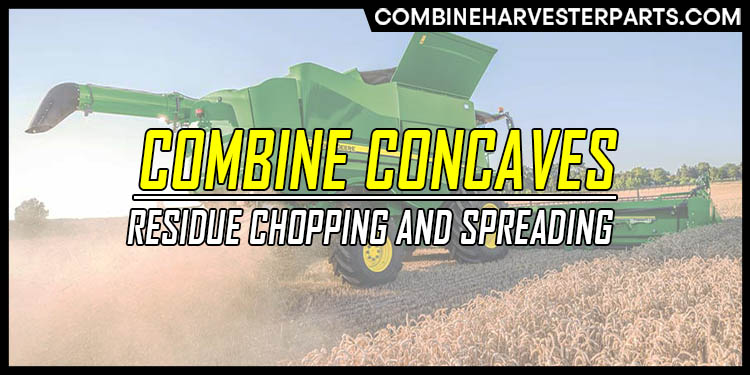
Overview Of Crop Residue Management
For better uniform stand establishment in the next season, it is crucial for the farmers to manage the residue carefully through effective chopping and spreading processes.
Management of the residue is mainly involved in even distribution of chaff and straw at the rear of the combine harvesters.
Crop Residue Components
The crop residues are mainly composed of straw, husk, chaff, corn cobs, hulls, and some cornstalk.
They are generally considered as integral organic fertilizers, organic materials for bedding and forage in the livestock industry, and for energy generation from direct combustion and biogas supply.
Regarding the flows of the outputs, every grain combine releases two material streams.
Straw is the material which goes through the threshing and separating units of the combine.
Chaff is the material that is blown or otherwise released from the cleaning unit of the combine.
Combine Equipment For Crop Residue Chopping And Spreading
Nowadays, combine harvesters have wider headers and grain platforms and concentrate a larger amount of plant material into the same narrow band exiting the combine.
Then, the material has to be spread back onto the wide harvest swath, challenging the residue managing task.
For uniform distribution enhancement, combine harvesters are now equipped with choppers, spreaders, or a combination of both for better residue processing.
In fact, combines with header widths of 20 to 30 feet or more may not be sufficiently equipped to uniformly scatter a large amount of residue.
These cases may call for adding manufacturer options or after-market equipment to achieve intensive residue management.
It is also necessary to modify, check, and maintain existing equipment.
For a better understanding of residue processing, the next section is going to discuss how important combines’ chopping and spreading processes are.
The Importance Of Proper Residue Chopping And Spreading
As mentioned above, the modern combine harvesters release larger volumes of material-other-than-grain (MOG) on a small-width swath compared to the width of the header.
Therefore, the weed and grain loss are concentrated at the back of the combine.
In fact, if the crop residues are left at the rear of the combine and are shallowly incorporated into the soil, the organic material’s accumulation in the upper soil layer turns out to be an issue because of their inadequate decomposition and conversion to humus.
When not gathered, managing the crop residue created from the crop harvesting is really essential for the following seeding process, especially a reduced or no-tillage process.
The soil heavy-harrowing would gather the straw and corn husks in bunches, which may not be well incorporated into the soil.
As a result, if all these residual components are not chopped and evenly spread earlier, they do not incorporate into the soil to deliver useful nutrients by mineralization.
The successful crop residue distribution can improve erosion protection and stand establishment.
It is thought that single-pass harrowing or cultivating of the soil is not as good as no-tillage since weed seeds are assimilated into the soil and loosen the stubble.
As a consequence, the failure of crop residue management inflicts a negative impact on the seeding process efficiency, creating the uneven distribution, hairpinning, plugging, soil aeration lack, and drying and finally, low and uneven germination and the development of the next crop seeds.
In short, uniform distribution has various benefits for farmers in no-till, minimum-till or conventional till systems, consisting of better erosion resistance, less plugging of tillage or seeding devices, and enhanced stand establishment.
Basic Requirements For Combine Harvester’s Residue Chopping And Spreading System
It is evident that the modern combine harvesters are designed with a chopping-spreading system that chops and spreads the straw, chaff, and husks uniformly across the header cutting width.
For excellent performance ensuring, the chopping and spreading system must meet a series of technological and process efficiency requirements, as below:
- Deliver consistent and uniform short chop length
- Uniformly spread the chopped material over the entire working width of the combine
- Produce a relatively low quantity of dust
- Use low driving power
- Need a low level of maintenance
In fact, material resistance to cutting largely depends on the physical and mechanical properties of MOG, feeding and discharging path of the material, and chopper knife design and kinematics.
The following section will unveil the construction of chopping and spreading systems that are equipped for the combine harvesters.
Construction Of Choppers And Spreaders
Generally speaking, a chopping and spreading system may implement the tasks with a single working unit that both chops and spreads the chopped material or may include two in-series units: chopper and spreader.
Chopping And Spreading System As A Single Unit
When the process is executed by a single unit, the process schematic is as displayed in the following figure.
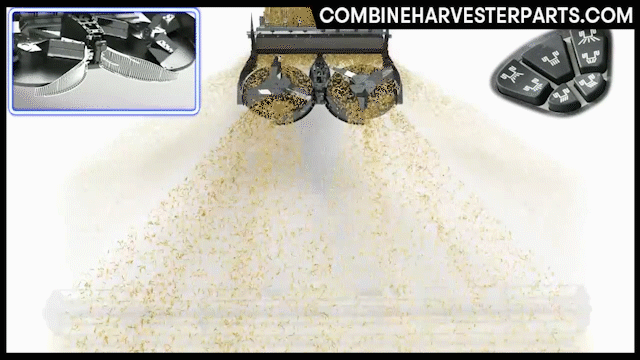
The straw that is discharged by the straw walkers or axial threshing unit is chopped into smaller pieces by the blades of a rotor or drum.
This rotor also generates airflow to facilitate spreading the chopped material behind the combine.
It could be equipped with four longitudinal rows of joined blades, which are available in two types: cutting blades and paddle blades.
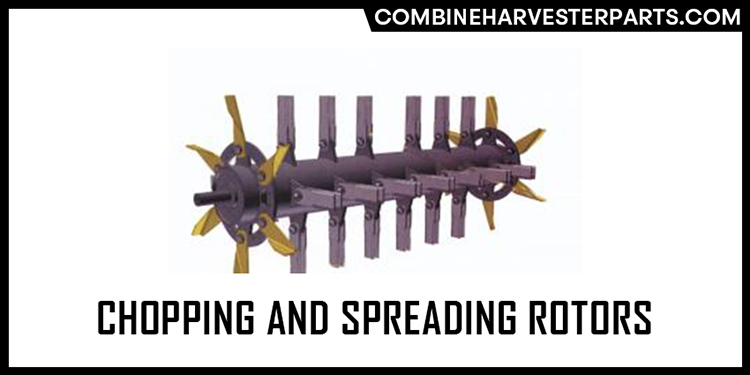
The crop residue is finely cut into uniform pieces by the straight, sharpened, and reversible blades.
Besides, the lateral fan blades produce high air velocities (up to 145 km/h or 90 mph).
The paddle blades enlarge the chopper airflow and spread width while enhancing the spreading uniformity across the combine working width.
In this situation, the chopped material is scattered through special shrouds.
Fairly different variants of this rotor are utilized in combine harvesters manufactured by Case IH, Caterpillar, New Holland, John Deere, and Massey Fergusson.
The common number of blades on the rotor is 72-88. Case IH combine harvesters sometimes feature a chopping rotor with multi-knife blades, which stand opposite orientation and are grouped in pairs attached on a helical path on the rotor barrel to require an even torque over a complete rotation.
In spite of various blade types, the blades are positioned within equally spaced transversal planes to the rotor axis to keep a consistent cut length and for process and power efficiency reasons.
To improve the cutting process efficiency, there is working conjunction between the cutting blades and stationary, yet adjustable counter-knives.
Chopping And Spreading System As Two In-Series Units
In this design, choppers and spreaders take charge of processing the waste material alternately.
As can be seen from the figure below, there are counter-knives of the chopping unit and a MOG spreading system, including two spinning discs which rotate opposite to each other.
Two spinning discs are required to spread the chopped material when the harvest swaths are greater than 7.5 m (25 ft). Otherwise, a single disc may be sufficient to execute this task.
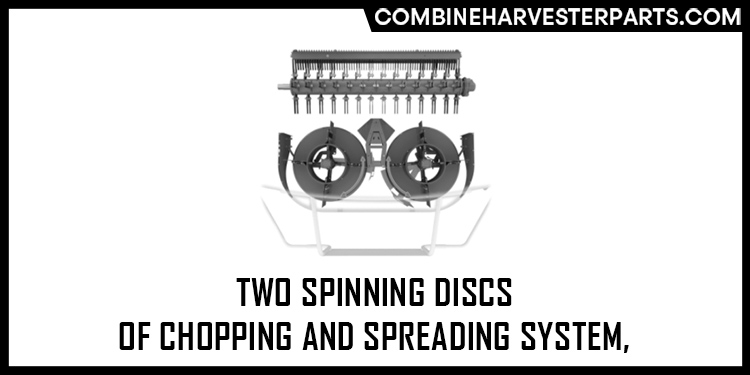
Straw choppers and spreaders are interchangeable on most combines, so the farmers can choose one of the versions: one disc, two discs, or a combination of both.
To enlarge material spreading scale and increase the uniformity, radial or curved vanes are mounted on the spinning disc’s surface.
The spreading width and distribution pattern are usually modified by
- Altering the fore-aft position where the material falls onto the spinning paddles
- Altering the angular position of deflectors or shields positioned around the disc’s border
- Altering the rotational speed of the discs
Crop Residue Chopping Process
The crop residue, which is discharged by straw walkers or the axial threshing unit and cleaning shoe, goes to the chopping process.
In fact, this is a cutting process of the material fibers by the edges of the cutting blades and counter-knives of the chopper based on the physical phenomena such as compression, bending, and local crushing of the material.
The deformations that occur in the material are determined by the form and orientation of the cutting edges and the process kinematics.
As a result, the cutting resistance of a material is vigorously associated with the shape and orientation of the cutting edges and kinematics of the process.
The material components’ orientation is random when it comes to contact with the active elements of the choppers.
These components can be cut individually or in bundles once formed.
The material cutting types can be categorized based on two criteria, as follows:
- Blade cutting edge’s position relative to the straw (stalk) fiber direction
- Blade movement’s direction relative to the cutting-edge direction
Based on the first criterion, accordingly, there are two types of cutting: cutback and splitting (defibration) that is cutting along the straw fiber direction.
Regarding the second criterion, the material can be sheared (when the blade speed’s direction is perpendicular to the cutting edge) or cut with sliding (the cutting edge slides over the material).
The second sort of cutting vigorously reduces the power requirement for the chopping process.
Drawn from the previous research on the cutting process, different design and functional factors have a significant influence on the cutting process efficiency and equipment performance.
Such factors consist of the blade speed, thickness, sharpness, bevel angle, edge serration, clearance between the edges, and physical and mechanical properties of cut material.
Crop Residue Spreading Process
The crop residue composed mainly from straw (stalks) and chaff can be spread in different ways as follows:
- The chaff and straw are spread separately. While straw is chopped and then spread, chaff is spread right after the cleaning process. The advantage of this design is separate setting of chaff and straw handling equipment, while the chopper is not overloaded by the chaff.
- The chaff and straw are chopped and spread together. The main benefit of this method is minimizing the dust, which preserves the environment and prevents the clogging of the cabin air conditioning filter and combine engine filter.
In terms of working, the spreading process is comparatively simple. In particular, the chopped material is fed at a certain radial distance into the spreading disc rotating uniformly in a horizontal or back-titled plane.
The effect of combined forces makes the material move on the disc surface along a curved path till it meets the vane, which acts as a guiding element until the particle leaves the disc and falls complying with the laws of physics.
Chaff spreaders are necessary for crops that generate a lot of light, fine crop material during grain threshing such as soybeans or wheat; besides, they may also be useful for corn. It is easy to distribute chaff with hydraulically driven single or dual spinning disks with rubber batts mounted to the end axle.
However, due to its lightweight, chaff is not able to spread beyond 20 to 25 feet with a single disk
Accordingly, dual chaff spreaders may be applied for the harvest swaths larger than 20 feet.
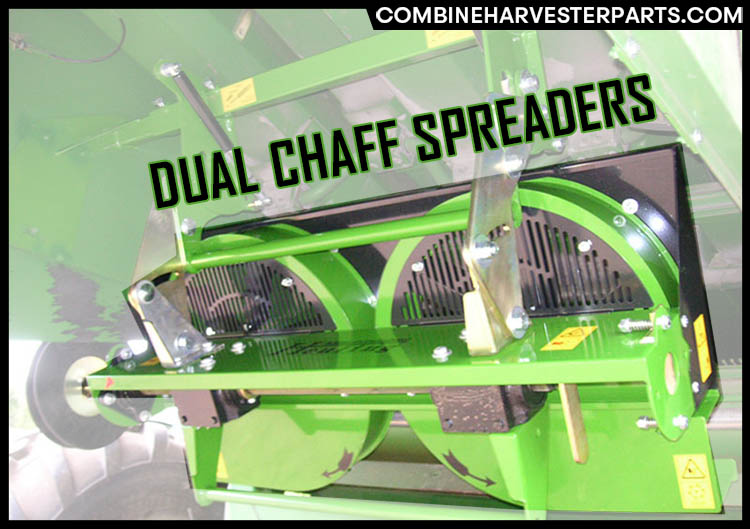
It is alterable for swath width and distribution patterns of chaff spreader by modifying the fore-aft position where material falls onto the spinning paddles, the deflectors or shields at multiple points surround the perimeter of the padded, and the speed of the spinners.
Conclusion
Combine harvesters’ residue chopping and spreading system has improved residue management critically.
In particular, this equipment helps chop the residual waste uniformly and spread it largely, usually relative to the combine width.
This system can be found in various versions: chopper, spreader, or a combination of both.
Also, it is beneficial to take advantage of the residue that can turn out to be the supply of nutrients for the next crops, and this just can be done with the involvement of the waste material chopping and spreading activities.
The article has thoroughly discussed the significance of residue management, the requirements for chopping and spreading activities, together with the construction of the system.
We hope you can find useful information in our article to address your existing inquiries about choppers and spreaders as well as related issues.
Besides, you can go through our other writings about other parts and components of combine harvesters.
References
- Manage combine residue for better stands next spring. Michigan Farm News. Retrieved May 20th, 2021.
- How combine makers are improving residue management tech. FWI. Retrieved May 20th, 2021.
- Miu, P. (2015). Combine Harvesters: Theory, Modeling, and Design. CRC Press.



